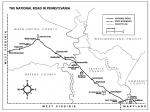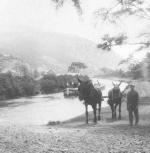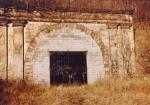Chapter Three: Pennsylvania Canal and Railroad
By the 1820s, the National Road was in operation from Cumberland, Maryland, to Wheeling, West Virginia. In New York, ground had been broken for the Erie Canal, which promised to open the west to the benefit of New York City. Time, it seemed, was running out for Pennsylvania to find a way to save their control over western trade. At the beginning of the nineteenth century, Pennsylvania and New York were the nation's most populous free states. Their leading cities, Philadelphia and New York City, were the nation's largest. Between these two mid-Atlantic communities, there was a growing rivalry for control of the nation's commercial future.
The key to commercial success in that era was the ability to control trade. A race soon developed to create a network of man-made waterways that would connect the two rival Atlantic coastal ports with the inland marketplace of the Ohio Valley and Great Lakes. Pennsylvania launched its first major state-sponsored canal-building project in the Schuylkill River valley in 1815. New York responded two years later with a more ambitious state-funded Erie Canal to connect Lake Erie to the Hudson River and ultimately New York City.
When the Erie Canal finally opened in New York State in 1825 (at about the same time as the opening of the Schuylkill Navigation), many business and political leaders in Pennsylvania realized they had missed an important economic opportunity by not being ambitious enough. They responded with a massive State Works project in 1826 that aimed to create six divisions of canals across every region of the state. At that time, the best option for transporting goods across the region was by piling them into Conestoga wagons and enduring up to three weeks over the state's complicated turnpike system. Canals promised faster, more efficient transportation.
Workers in Harrisburg broke ground for the Main Line of the Pennsylvania Canal from Philadelphia to Pittsburgh in 1826 and completed the major portion of the labor by 1834. The cost exceeded $10 million. The first section of the canal extended from Philadelphia westward to Hollidaysburg, Blair County, utilizing the waters of the Schuylkill, Susquehanna and Juniata Rivers. The second section of the canal extended eastward from Pittsburgh to Johnstown, Cambria County, following the water flow of the Allegheny, Kiskiminetas, and Conemaugh Rivers.
Pennsylvania Canal from Philadelphia to Pittsburgh in 1826 and completed the major portion of the labor by 1834. The cost exceeded $10 million. The first section of the canal extended from Philadelphia westward to Hollidaysburg, Blair County, utilizing the waters of the Schuylkill, Susquehanna and Juniata Rivers. The second section of the canal extended eastward from Pittsburgh to Johnstown, Cambria County, following the water flow of the Allegheny, Kiskiminetas, and Conemaugh Rivers.
Building waterways forty feet wide and four feet deep across the southern edge of the state was a marvelous accomplishment, but the most magnificent component of the Main Line was the construction of the Allegheny Portage Railroad in the early 1830s. Opened on March 18, 1834, the Portage Railroad connected two bodies of water at Hollidaysburg and Johnstown in an unprecedented line that crossed directly over the Allegheny Mountains.
Allegheny Portage Railroad in the early 1830s. Opened on March 18, 1834, the Portage Railroad connected two bodies of water at Hollidaysburg and Johnstown in an unprecedented line that crossed directly over the Allegheny Mountains.
The nation's brightest engineers had designed double-track inclined planes to overcome an elevation of 1,400 feet from the headwaters of the Juniata to the Summit, and 1,175 feet from the Little Conemaugh River to the Summit. The Portage Railroad was not exactly a railroad, but rather a series of tiered, inclined planes that essentially pulled loads over the mountain by moving cars up and down simultaneously to balance the shifting cargo. At first, horses powered the movement of the rail cars (just as they helped tow canal boats) but eventually steam locomotives were designed to power the innovative rail system. The cars had to be coupled and uncoupled 33 times during the 36-mile route.
An early passenger, the British novelist Charles Dickens, succinctly described the railroad as "ten inclined planes; five ascending and five descending; the carriages are dragged up the former, and slowly let down the latter, by means of stationary engines; the comparatively level spaces between being traversed sometimes by horse and sometimes by engine power, as the case demands."
Two Canal Basins were placed at either end of the portage railroad. Essentially large holding ponds, the basins often looked like large warehouses or modern day airports as boats loaded with agricultural produce and industrial goods, and often hundreds of passengers, waited to be hauled the 36 miles from Hollidaysburg to Johnstown.
Canal Basins were placed at either end of the portage railroad. Essentially large holding ponds, the basins often looked like large warehouses or modern day airports as boats loaded with agricultural produce and industrial goods, and often hundreds of passengers, waited to be hauled the 36 miles from Hollidaysburg to Johnstown.
Another marvelous feature of the new Allegheny Portage Railroad was the first railroad tunnel built in the United States. Staple Bend Tunnel measured 901 feet in length. Skilled artisans crafted the sandstone entryways and lined the tunnel walls with finely cut stones. Laborers toiled for months to drill through the solid stone of the Alleghenies
Staple Bend Tunnel measured 901 feet in length. Skilled artisans crafted the sandstone entryways and lined the tunnel walls with finely cut stones. Laborers toiled for months to drill through the solid stone of the Alleghenies
Mifflin County was one of the major hubs on the Pennsylvania Canal and a focal point of Pennsylvania Travel History. Since it was centrally located, the county had become a crossroads for commercial traffic, first in the turnpike era, then from the canal, and later during the heyday of the Pennsylvania Railroad.
Travel History. Since it was centrally located, the county had become a crossroads for commercial traffic, first in the turnpike era, then from the canal, and later during the heyday of the Pennsylvania Railroad.
The Pennsylvania Canal operated at peak capacity for about twenty-three years, but historians acknowledge that the engineering marvel was at least partly obsolete within five years after its completion. Steam locomotives on modern rail lines proved faster and more efficient as a means for commercial transportation. Between 1835 and 1850, more railroad building was done in Pennsylvania than in any other state. These tracks formed the nucleus of the Pennsylvania Railroad.
The driving force behind the nation's largest railroad company was J. Edgar Thomson, who served first as Chief Engineer and later as President. Under Thomson's direction, the Pennsylvania Railroad helped consolidate what had been a chaotic early railroad industry in Pennsylvania. Just as there had once been hundreds of turnpike companies, during the 1830s and 1840s there was a surplus of private railroad companies. By the Civil War era, the Pennsylvania Railroad bought out most of them. During the decades after the war, the company emerged as one of the nation's largest.
J. Edgar Thomson, who served first as Chief Engineer and later as President. Under Thomson's direction, the Pennsylvania Railroad helped consolidate what had been a chaotic early railroad industry in Pennsylvania. Just as there had once been hundreds of turnpike companies, during the 1830s and 1840s there was a surplus of private railroad companies. By the Civil War era, the Pennsylvania Railroad bought out most of them. During the decades after the war, the company emerged as one of the nation's largest.
By the 1850s, the Pennsylvania Railroad purchased the canal line and shifted most of its commercial traffic to its main rail route through the state. Its work, however, was not done. The Allegheny Mountains still posed a significant challenge to transportation, even in the industrial age. Seeking to replace the costly and cumbersome Portage Railroad, the Pennsylvania Railroad constructed a pair of innovative designs to conquer the great divide. The first, Horseshoe Curve, formed a long, double-back loop that allowed the trains to gain altitude at a gentle rate.
At the end of the Curve, the tracks continued until joined by the Gallitzin Tunnels, a massive 3,612 foot-long engineering accomplishment. The Gallitzin Tunnels stood twenty-two feet high by twenty-four feet wide and cost approximately $450,000 to complete. Irish and Welsh laborers, brought in by the railroad and skilled in excavation and blasting, labored on both. Their efforts, using picks, shovels, and blasting powder, constructed the two largest engineering accomplishments of the railroads. In 1854, the passenger service between Philadelphia and Pittsburgh began, and the average trip took just fifteen hours and cost $8.00 a ticket.
The construction of the railroads and the need for repair facilities also created the town of Altoona in Blair County. In 1849, the Pennsylvania Railroad chose it as the site to build the Pennsylvania Railroad Shops. At this location, the company created a mammoth complex that allowed it to become the first within the industry to be self-sufficient in manufacturing, repair, and service for its fleet of locomotives, freight, and passenger rail cars.
Pennsylvania Railroad Shops. At this location, the company created a mammoth complex that allowed it to become the first within the industry to be self-sufficient in manufacturing, repair, and service for its fleet of locomotives, freight, and passenger rail cars.
The key to commercial success in that era was the ability to control trade. A race soon developed to create a network of man-made waterways that would connect the two rival Atlantic coastal ports with the inland marketplace of the Ohio Valley and Great Lakes. Pennsylvania launched its first major state-sponsored canal-building project in the Schuylkill River valley in 1815. New York responded two years later with a more ambitious state-funded Erie Canal to connect Lake Erie to the Hudson River and ultimately New York City.
When the Erie Canal finally opened in New York State in 1825 (at about the same time as the opening of the Schuylkill Navigation), many business and political leaders in Pennsylvania realized they had missed an important economic opportunity by not being ambitious enough. They responded with a massive State Works project in 1826 that aimed to create six divisions of canals across every region of the state. At that time, the best option for transporting goods across the region was by piling them into Conestoga wagons and enduring up to three weeks over the state's complicated turnpike system. Canals promised faster, more efficient transportation.
Workers in Harrisburg broke ground for the Main Line of the
Building waterways forty feet wide and four feet deep across the southern edge of the state was a marvelous accomplishment, but the most magnificent component of the Main Line was the construction of the
The nation's brightest engineers had designed double-track inclined planes to overcome an elevation of 1,400 feet from the headwaters of the Juniata to the Summit, and 1,175 feet from the Little Conemaugh River to the Summit. The Portage Railroad was not exactly a railroad, but rather a series of tiered, inclined planes that essentially pulled loads over the mountain by moving cars up and down simultaneously to balance the shifting cargo. At first, horses powered the movement of the rail cars (just as they helped tow canal boats) but eventually steam locomotives were designed to power the innovative rail system. The cars had to be coupled and uncoupled 33 times during the 36-mile route.
An early passenger, the British novelist Charles Dickens, succinctly described the railroad as "ten inclined planes; five ascending and five descending; the carriages are dragged up the former, and slowly let down the latter, by means of stationary engines; the comparatively level spaces between being traversed sometimes by horse and sometimes by engine power, as the case demands."
Two
Another marvelous feature of the new Allegheny Portage Railroad was the first railroad tunnel built in the United States.
Mifflin County was one of the major hubs on the Pennsylvania Canal and a focal point of Pennsylvania
The Pennsylvania Canal operated at peak capacity for about twenty-three years, but historians acknowledge that the engineering marvel was at least partly obsolete within five years after its completion. Steam locomotives on modern rail lines proved faster and more efficient as a means for commercial transportation. Between 1835 and 1850, more railroad building was done in Pennsylvania than in any other state. These tracks formed the nucleus of the Pennsylvania Railroad.
The driving force behind the nation's largest railroad company was
By the 1850s, the Pennsylvania Railroad purchased the canal line and shifted most of its commercial traffic to its main rail route through the state. Its work, however, was not done. The Allegheny Mountains still posed a significant challenge to transportation, even in the industrial age. Seeking to replace the costly and cumbersome Portage Railroad, the Pennsylvania Railroad constructed a pair of innovative designs to conquer the great divide. The first, Horseshoe Curve, formed a long, double-back loop that allowed the trains to gain altitude at a gentle rate.
At the end of the Curve, the tracks continued until joined by the Gallitzin Tunnels, a massive 3,612 foot-long engineering accomplishment. The Gallitzin Tunnels stood twenty-two feet high by twenty-four feet wide and cost approximately $450,000 to complete. Irish and Welsh laborers, brought in by the railroad and skilled in excavation and blasting, labored on both. Their efforts, using picks, shovels, and blasting powder, constructed the two largest engineering accomplishments of the railroads. In 1854, the passenger service between Philadelphia and Pittsburgh began, and the average trip took just fifteen hours and cost $8.00 a ticket.
The construction of the railroads and the need for repair facilities also created the town of Altoona in Blair County. In 1849, the Pennsylvania Railroad chose it as the site to build the


















